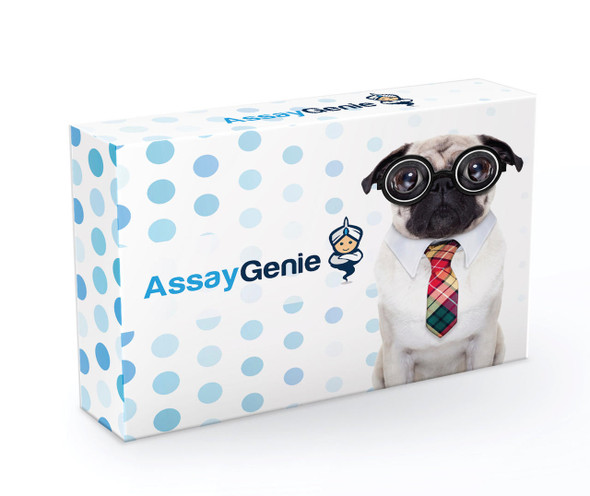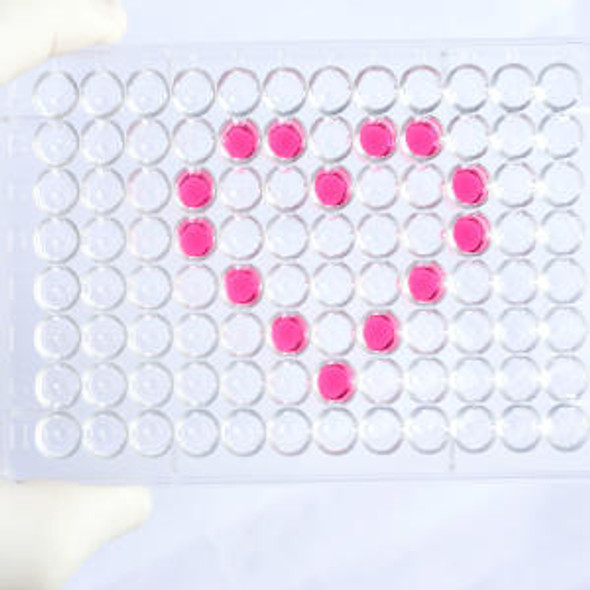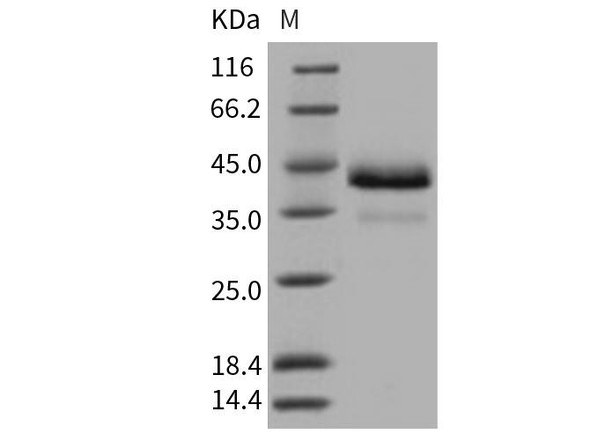Human Cell Biology ELISA Kits 3
Human CTSB (Cathepsin B) CLIA Kit (HUES00018)
- SKU:
- HUES00018
- Product Type:
- ELISA Kit
- ELISA Type:
- CLIA Kit
- Size:
- 96 Assays
- Sensitivity:
- 18.75pg/mL
- Range:
- 31.25-2000pg/mL
- ELISA Type:
- Sandwich
- Synonyms:
- APPS, CPSB
- Reactivity:
- Human
- Sample Type:
- Serum, plasma and other biological fluids
- Research Area:
- Cell Biology
Description
| Assay type: | Sandwich |
| Format: | 96T |
| Assay time: | 4.5h |
| Reactivity: | Human |
| Detection method: | Chemiluminescence |
| Detection range: | 31.25-2000 pg/mL |
| Sensitivity: | 18.75 pg/mL |
| Sample volume: | 100µL |
| Sample type: | Serum, plasma and other biological fluids |
| Repeatability: | CV < 15% |
| Specificity: | This kit recognizes Human CTSB in samples. No significant cross-reactivity or interference between Human CTSB and analogues was observed. |
This kit uses Sandwich-CLIA as the method. The micro CLIA plate provided in this kit has been pre-coated with an antibody specific to Human CTSB. Standards or samples are added to the appropriate micro CLIA plate wells and combined with the specific antibody. Then a biotinylated detection antibody specific for Human CTSB and Avidin-Horseradish Peroxidase (HRP) conjugate are added to each micro plate well successively and incubated. Free components are washed away. The substrate solution is added to each well. Only those wells that contain Human CTSB, biotinylated detection antibody and Avidin-HRP conjugate will appear fluorescence. The Relative light unit (RLU) value is measured spectrophotometrically by the Chemiluminescence immunoassay analyzer. The RLU value is positively associated with the concentration of Human CTSB. The concentration of Human CTSB in the samples can be calculated by comparing the RLU of the samples to the standard curve.
| UniProt Protein Function: | CTSB: Thiol protease which is believed to participate in intracellular degradation and turnover of proteins. Has also been implicated in tumor invasion and metastasis. Dimer of a heavy chain and a light chain cross-linked by a disulfide bond. Interacts with SRPX2. Belongs to the peptidase C1 family. |
| UniProt Protein Details: | Protein type:Motility/polarity/chemotaxis; Protease; Autophagy; EC 3. 4. 22. 1 Chromosomal Location of Human Ortholog: 8p22 Cellular Component: apical plasma membrane; caveola; external side of plasma membrane; extracellular region; extracellular space; intracellular; intracellular membrane-bound organelle; lysosome; melanosome; mitochondrion; nucleolus; perinuclear region of cytoplasm; sarcolemma Molecular Function:collagen binding; cysteine-type endopeptidase activity; cysteine-type peptidase activity; kininogen binding; peptidase activity; peptide binding; protein binding; protein self-association; proteoglycan binding Biological Process: autophagy; collagen catabolic process; decidualization; entry of virus into host cell; epithelial cell differentiation; extracellular matrix disassembly; extracellular matrix organization and biogenesis; innate immune response; proteolysis; proteolysis involved in cellular protein catabolic process; regulation of apoptosis; regulation of catalytic activity; response to amine stimulus; response to ethanol; response to glucose stimulus; response to organic cyclic substance; response to peptide hormone stimulus; response to wounding; skeletal muscle development; spermatogenesis; toll-like receptor signaling pathway |
| NCBI Summary: | This gene encodes a member of the C1 family of peptidases. Alternative splicing of this gene results in multiple transcript variants. At least one of these variants encodes a preproprotein that is proteolytically processed to generate multiple protein products. These products include the cathepsin B light and heavy chains, which can dimerize to form the double chain form of the enzyme. This enzyme is a lysosomal cysteine protease with both endopeptidase and exopeptidase activity that may play a role in protein turnover. It is also known as amyloid precursor protein secretase and is involved in the proteolytic processing of amyloid precursor protein (APP). Incomplete proteolytic processing of APP has been suggested to be a causative factor in Alzheimer's disease, the most common cause of dementia. Overexpression of the encoded protein has been associated with esophageal adenocarcinoma and other tumors. Multiple pseudogenes of this gene have been identified. [provided by RefSeq, Nov 2015] |
| UniProt Code: | P07858 |
| NCBI GenInfo Identifier: | 68067549 |
| NCBI Gene ID: | 1508 |
| NCBI Accession: | P07858. 3 |
| UniProt Secondary Accession: | P07858,Q503A6, Q96D87, B3KQR5, B3KRR5, |
| UniProt Related Accession: | P07858 |
| Molecular Weight: | 37,822 Da |
| NCBI Full Name: | Cathepsin B |
| NCBI Synonym Full Names: | cathepsin B |
| NCBI Official Symbol: | CTSB |
| NCBI Official Synonym Symbols: | APPS; CPSB |
| NCBI Protein Information: | cathepsin B |
| UniProt Protein Name: | Cathepsin B |
| UniProt Synonym Protein Names: | APP secretase; APPS |
| Protein Family: | Cathepsin |
| UniProt Gene Name: | CTSB |
| UniProt Entry Name: | CATB_HUMAN |
As the RLU values of the standard curve may vary according to the conditions of the actual assay performance (e. g. operator, pipetting technique, washing technique or temperature effects), the operator should establish a standard curve for each test. Typical standard curve and data is provided below for reference only.
| Concentration (pg/mL) | RLU | Average | Corrected |
| 2000 | 52934 58508 | 55721 | 55693 |
| 1000 | 22761 25187 | 23974 | 23946 |
| 500 | 11762 10302 | 11032 | 11004 |
| 250 | 5254 5334 | 5294 | 5266 |
| 125 | 2685 2531 | 2608 | 2580 |
| 62.5 | 1390 1232 | 1311 | 1283 |
| 31.25 | 651 697 | 674 | 646 |
| 0 | 27 29 | 28 | -- |
Precision
Intra-assay Precision (Precision within an assay): 3 samples with low, mid range and high level Human CTSB were tested 20 times on one plate, respectively.
Inter-assay Precision (Precision between assays): 3 samples with low, mid range and high level Human CTSB were tested on 3 different plates, 20 replicates in each plate.
| Intra-assay Precision | Inter-assay Precision | |||||
| Sample | 1 | 2 | 3 | 1 | 2 | 3 |
| n | 20 | 20 | 20 | 20 | 20 | 20 |
| Mean (pg/mL) | 100.33 | 277.70 | 727.18 | 92.77 | 304.35 | 793.10 |
| Standard deviation | 8.14 | 28.52 | 62.46 | 11.96 | 22.92 | 89.54 |
| C V (%) | 8.11 | 10.27 | 8.59 | 12.89 | 7.53 | 11.29 |
Recovery
The recovery of Human CTSB spiked at three different levels in samples throughout the range of the assay was evaluated in various matrices.
| Sample Type | Range (%) | Average Recovery (%) |
| Serum (n=5) | 98-111 | 104 |
| EDTA plasma (n=5) | 101-116 | 108 |
| Cell culture media (n=5) | 100-114 | 106 |
Linearity
Samples were spiked with high concentrations of Human CTSB and diluted with Reference Standard & Sample Diluent to produce samples with values within the range of the assay.
| Serum (n=5) | EDTA plasma (n=5) | Cell culture media (n=5) | ||
| 1:2 | Range (%) | 84-96 | 86-102 | 95-111 |
| Average (%) | 90 | 93 | 101 | |
| 1:4 | Range (%) | 97-114 | 101-115 | 99-118 |
| Average (%) | 104 | 106 | 108 | |
| 1:8 | Range (%) | 86-98 | 99-113 | 93-110 |
| Average (%) | 93 | 106 | 101 | |
| 1:16 | Range (%) | 100-113 | 91-107 | 99-113 |
| Average (%) | 107 | 98 | 104 |
An unopened kit can be stored at 4°C for 1 month. If the kit is not used within 1 month, store the items separately according to the following conditions once the kit is received.
| Item | Specifications | Storage |
| Micro CLIA Plate(Dismountable) | 8 wells ×12 strips | -20°C, 6 months |
| Reference Standard | 2 vials | |
| Concentrated Biotinylated Detection Ab (100×) | 1 vial, 120 µL | |
| Concentrated HRP Conjugate (100×) | 1 vial, 120 µL | -20°C(shading light), 6 months |
| Reference Standard & Sample Diluent | 1 vial, 20 mL | 4°C, 6 months |
| Biotinylated Detection Ab Diluent | 1 vial, 14 mL | |
| HRP Conjugate Diluent | 1 vial, 14 mL | |
| Concentrated Wash Buffer (25×) | 1 vial, 30 mL | |
| Substrate Reagent A | 1 vial, 5 mL | 4°C (shading light) |
| Substrate Reagent B | 1 vial, 5 mL | 4°C (shading light) |
| Plate Sealer | 5 pieces | |
| Product Description | 1 copy | |
| Certificate of Analysis | 1 copy |
- Set standard, test sample and control (zero) wells on the pre-coated plate and record theirpositions. It is recommended to measure each standard and sample in duplicate. Note: addall solutions to the bottom of the plate wells while avoiding contact with the well walls. Ensuresolutions do not foam when adding to the wells.
- Aliquot 100µl of standard solutions into the standard wells.
- Add 100µl of Sample / Standard dilution buffer into the control (zero) well.
- Add 100µl of properly diluted sample (serum, plasma, tissue homogenates and otherbiological fluids. ) into test sample wells.
- Cover the plate with the sealer provided in the kit and incubate for 90 min at 37°C.
- Aspirate the liquid from each well, do not wash. Immediately add 100µL of BiotinylatedDetection Ab working solution to each well. Cover the plate with a plate seal and gently mix. Incubate for 1 hour at 37°C.
- Aspirate or decant the solution from the plate and add 350µL of wash buffer to each welland incubate for 1-2 minutes at room temperature. Aspirate the solution from each well andclap the plate on absorbent filter paper to dry. Repeat this process 3 times. Note: a microplatewasher can be used in this step and other wash steps.
- Add 100µL of HRP Conjugate working solution to each well. Cover with a plate seal andincubate for 30 min at 37°C.
- Aspirate or decant the solution from each well. Repeat the wash process for five times asconducted in step 7.
- Add 100µL of Substrate mixture solution to each well. Cover with a new plate seal andincubate for no more than 5 min at 37°C. Protect the plate from light.
- Determine the RLU value of each well immediately.






